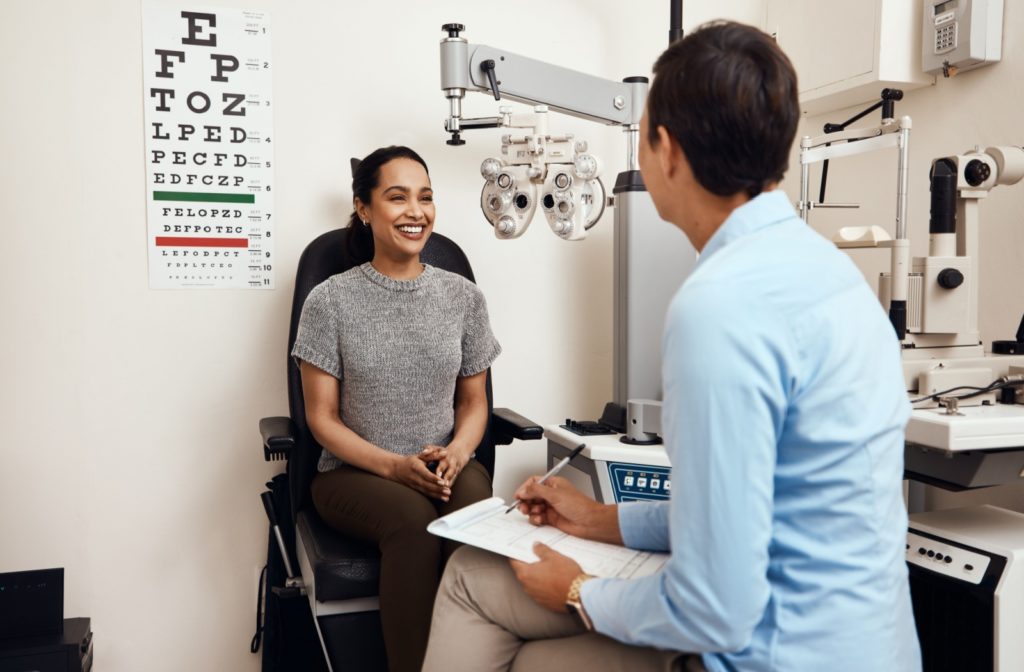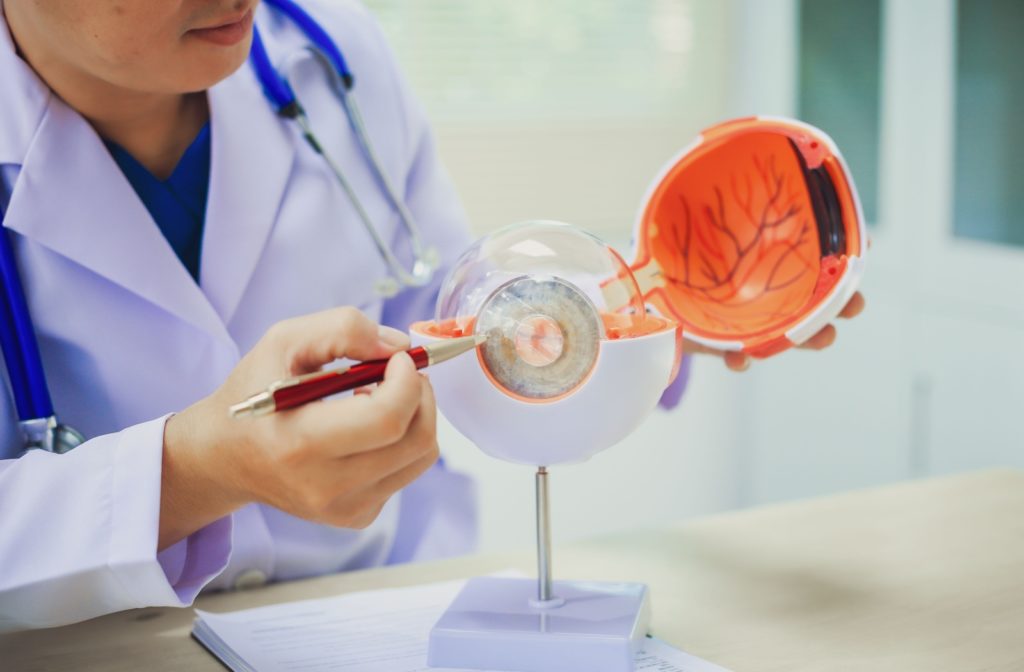Myopia is a common refractive error that causes blurry distance vision, while nearby vision remains clear. Although it’s considered a relatively harmless eye condition, leaving it unmanaged can cause myopia to progress into its more severe form, known as high myopia.
High myopia may place additional stress on the eyes, potentially increasing the risk of developing serious conditions like cataracts and glaucoma.
Starting myopia control therapies early may help slow myopia progression, potentially reducing the potential for high myopia and associated vision risks.
Defining High Myopia
Myopia develops because of structural changes in the eye’s shape. It causes the eye to elongate or the cornea to become overly curved, causing light entering the eye to focus incorrectly in front of the retina, instead of directly on it.
High myopia is a more severe form of this otherwise common refractive error. It’s typically diagnosed when a person’s refractive error exceeds -6.00 diopters, and the eye elongation becomes even more pronounced. As myopia worsens, nearby vision gradually becomes blurrier alongside distance vision.
Although myopia is common and manageable with corrective lenses, high myopia is more complex and goes beyond vision correction, affecting the eyes’ structural integrity.
The physical elongation of the eye stretches the retina, optic nerve, and other delicate structures, making them more vulnerable to damage over time.
This weakening increases the likelihood of developing vision-threatening conditions, including cataracts and glaucoma, which can severely impact eye health if left untreated.
High Myopia’s Role in Cataract Development
Cataracts are an eye condition that clouds the eye’s natural lens, which is responsible for focusing light on the retina for clear vision. Incoming light struggles to pass through the clouded lens, causing blurry or dimmed vision.
Although cataracts can develop naturally, age isn’t the only determining factor. High myopia, for instance, can accelerate its formation, affecting people of all ages.
Eyes with high myopia experience increased oxidative stress and structural strain, potentially accelerating the breakdown of the lens proteins. Studies have shown that those with high myopia may be more prone to developing cataracts earlier and could require more complex surgical procedures if cataract removal becomes necessary.
High Myopia’s Role in Glaucoma Development
Glaucoma is a group of eye conditions that damage the optic nerve, a structure responsible for transmitting visual information from the eye to the brain. Damage to the optic nerve disrupts the flow of visual signals and creates blind spots in your field of vision.
Elevated eye pressure is generally what causes this damage. But, this condition develops silently. The onset of noticeable symptoms often signals that the condition may have progressed.
High myopia has been associated with thinning of the optic nerve and structural changes in the eye, which may contribute to an increased risk of glaucoma. Additionally, elevated eye pressure in myopic eyes can exacerbate optic nerve damage. Studies show that those with high myopia are at a higher risk for both open-angle and angle-closure glaucoma.

Introducing Myopia Control Therapies
Cataract surgery has a high success rate in curing cataracts by replacing the clouded lens with an artificial one, but this otherwise simple and common procedure becomes more complex in an eye with high myopia. Meanwhile, there’s no cure for glaucoma, just treatment measures to slow optic nerve damage.
Therefore, slowing myopia progression may help reduce the likelihood of developing these eye conditions and support long-term vision health.
Currently, there is no cure for myopia, and since it develops from physical changes in the eye’s shape, it can’t be reversed either. Fortunately, myopia control therapies may help slow myopia progression by addressing eye elongation.
The ideal time to start myopia control therapies is when myopia is diagnosed. This is often during childhood between the ages of 6 and 12. Early implementation is recommended because myopia tends to progress more rapidly during these formative years.
During these years, the eyes are still developing, making them more adaptable to changes. Delaying therapy may allow myopia to worsen unchecked, increasing the risk of high myopia later in life, and subsequently, a greater risk of developing cataracts or glaucoma.
Myopia Control Options with Calgary Optometry Centre
Our team recognizes the importance of proactive myopia management, which is why we offer three therapies to help slow myopia progression and protect your eye health.
We tailor each treatment plan to meet our patient’s needs, for a comfortable myopia management journey.
Atropine Drops
These medicated eye drops–taken once daily–contain a low dose of atropine, a compound that helps to slow the elongation of the eye.
These drops dilate the pupil, temporarily relaxing the eye’s focusing muscles, and regulating how light enters the eye. Studies suggest this adjustment reduces signaling pathways in the eye that drive excessive growth.
Orthokeratology Lenses
Orthokeratology (ortho-k) lenses are customized gas-permeable lenses for overnight wear that gently reshape the cornea while you sleep. They temporarily alter the shape of the cornea, correcting refractive errors, and allowing the wearer to experience clear vision during the day without the support of corrective lenses.
Their ability to slow progression lies in this temporary reshaping, which alters how light enters and focuses within the eye, regulating eye growth and halting its elongation.
Unlike some other myopia control therapies, ortho-k has been shown to help stabilize myopia progression in adults up to age 29.
Multifocal Contact Lenses
These contact lenses are typically used to correct presbyopia. However, the incorporation of multiple zones of focus within a single lens can sometimes help slow myopia progression in children.
Their design allows them to simultaneously provide clear vision for distance, intermediate, and near tasks while creating a defocused image in the peripheral retina. This defocus helps to reduce the stimulus for eye elongation.
Start the Journey to Myopia Control
Managing myopia progression is recommended to help decrease the risk of developing high myopia and other serious eye conditions that could threaten your vision and eye health.
Connect with our Calgary Optometry Centre team to schedule a myopia control consultation.




